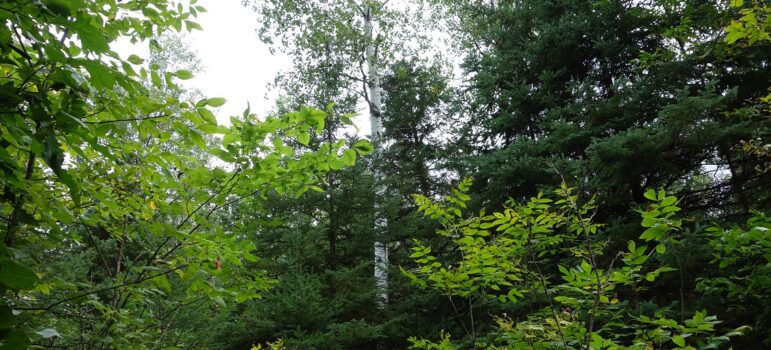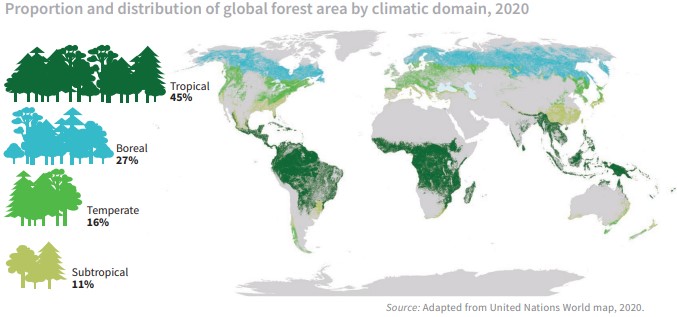
Minnesota DNR
Researchers find that climate change has deadly effects on trees such as these in a Northern boreal forest.By MACKENZIE DeRAAD
Capital News Service
A new study by researchers from the University of Michigan, University of Minnesota Twin Cities and their collaborators shows the deadly effect global warming is having on nine North American tree species growing in similar habitats.
They looked at balsam fir, white spruce, jack pine, Eastern white pine, red maple, sugar maple, paper birch, bur oak and Northern red oak.
These species make up boreal forests, which, by definition, grow at high latitudes and can withstand freezing temperatures six to eight months of the year. They reach into northern parts of the Great Lakes Basin.
Climate change is causing higher instances of melted permafrost, tree growth rate changes and increased drought and wildfire incidents, according to the International Boreal Forest Research Association.
Boreal forests make up the world’s largest land biome — or ecosystem — so it’s no surprise that climate change is affecting them more rapidly than other ecosystems, scientists say.
Juvenile trees are experiencing increased mortality due to global warming and reduced rainfall, according to the study. Reduced rainfall during the summer, that is.
Peter Reich, the lead author of the study published in the journal “Nature,” said, “If anything, (annual rainfall) has increased.”
Other members of the research team are from the University of Michigan, the Smithsonian Environmental Research Center and West Sydney University in Australia.
“Recently and in the expected future, more of that annual precipitation will fall in late winter and spring and less in late summer,” Reich added.
Climate change is even leading to increased rainfall in fewer precipitation events, leading to more runoff and, thus, greater periods of soil recharge, according to Reich.
More runoff means more flooding because the soil is too dry to absorb massive amounts of rainfall quickly, but the drought periods give soil time to store water and “recharge.”
But rainfall can’t keep up with increasing temperatures.
“Every 1 degree (Celsius) increase in temperature translates into 7% more evapotranspiration (evaporation from soil and transpiration from plants, transferring water from land to the atmosphere), so rainfall would need to increase by 7% to even keep pace with water loss,” Reich added.
More spring flooding and summer droughts are not a good combination for juvenile boreal forests, according to Reich.
The nine species differed in how their growth responded to warming temperatures, according to the study.
Red maple and sugar maple experienced enhanced growth, while balsam fir, white spruce and Eastern white pine experienced severe growth reductions.
The authors concluded that climate change, especially global warming, will shift the demographic of tree species in current boreal forests to more temperate species.
The implications of their findings are clear.
“We sit at the transition from temperate to boreal,” Reich said.
“Boreal species are at their warmer range margins in the Great Lakes region, so further warming places them at risk of poor growth and greater mortality.”
He said he hopes that oak, maple and other temperate species can do well in the same zones, and spruce and firs may disappear from the Great Lakes region incoming years.
So what can be done to stop the trees from disappearing?
“Stopping climate change is priority numbers 1, 2 and 3,” Reich said.
But that’s a complex solution with many different avenues.
Planting more “climate-smart” trees and thinning forests to reduce water demand and wildfire risk is a start, according to Reich.
Keeping carbon in place is also an objective to combat climate change.
The Boreal Wildlands Carbon Project, headed by Nature Conservancy of Canada, allows corporations to purchase carbon offsets to mitigate the effects of their greenhouse gas emissions.
According to the Nature Conservancy of Canada, Boreal Wildlands Project land stores roughly 190 million tons of carbon, equivalent to emissions produced by about 3 million cars.
Nature Conservancy of Canada director of communications Andrew Holland said the project is like a template for other projects across the globe.
He added that it’s a prime example of “acting locally but thinking globally.”
Mackenzie DeRaad reports for Great Lakes Echo.

Food and Agriculture Organization of the United Nations
A map shows boreal, temperate, tropical and subtropical forest geographic distribution.